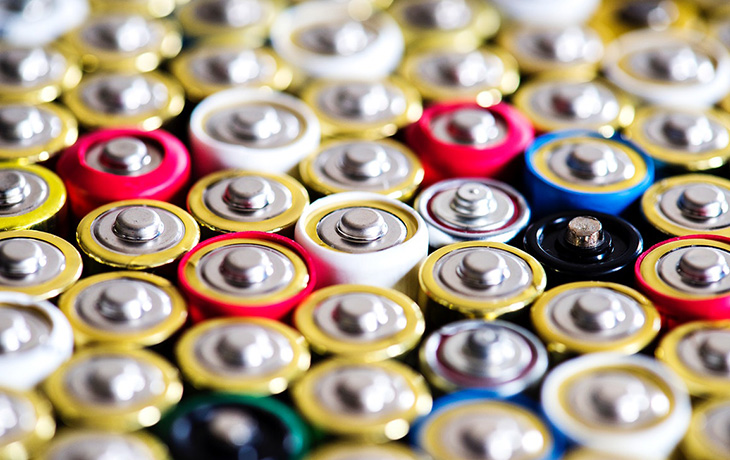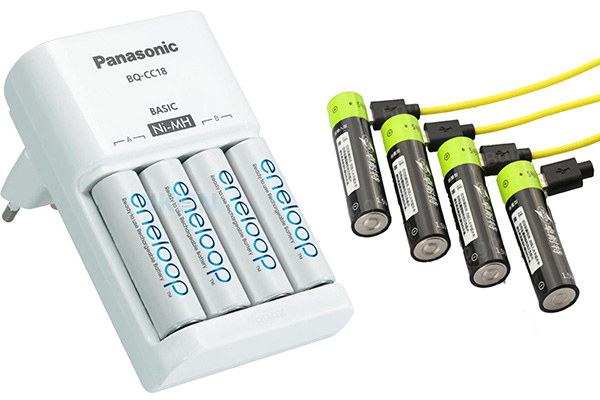Imagine using a flashlight, with more than enough light to read and do real work for one hour every night, for over eight years before having to replace the battery. Or battery-powered devices that you can still use decades into a permanent grid-down scenario.
Modern battery technology has changed the game for preppers — so don’t just grab a pack of the same old alkaline Duracells at the supermarket checkout lane or the cheap Amazon Basics and move on.
A modern-day battery is not a consumable like water, food, or fuel. Rather, it’s a wear part, like tires, springs, blades, and other bits and pieces you use and re-use until they wear out. A well-maintained, rechargeable battery should last you years of daily use — maybe even a decade or more — before it needs replacement.
We dig into details below, but if you just want the quick answers:
- Skip common alkaline batteries — they seem cheap-up front, but there are much better choices for both daily life and emergencies
- Standardize on the AA form-factor family (AAA, AA, C, etc.) wherever possible, rather than weird “hearing aid” batteries or the latest and greatest tactical batteries, so that it’s easier to find replacements
- Move your daily-life electronics to rechargeable NiMH LSD batteries — they serve double duty for pre- and post-emergency
- Gear you don’t use very often but want to know it will work when you do, like a radio in your go-bag, can be either rechargeable NiMH or disposable lithium
- Store lithium-based disposable batteries for long-term backups because they have the best shelf life, often holding >80% of their charge after 15-20 years
- Rechargeables with integrated micro-USB plugs are great because you already have USB charging gear around your home and in your go-bags (or other people around you will have it in an emergency)
- Lithium-ion rechargeable power packs (commonly used for recharging cell phones and tablets on the go) are useful for everyday carry, but the Li-Ion chemistry is usually not the best choice for preparedness because it doesn’t hold a charge well long-term
- Keeping batteries cool and dry — you can even store them in your fridge — will increase lifespan and performance
Buy what the battery experts recommend:
Be prepared. Don’t be a victim.
Want more great content and giveaways? Sign up for The Prepared’s free newsletter and get the best prepping content straight to your inbox. 1-2 emails a month, 0% spam.
- Why you should trust us
- Common battery types and basic 101
- Which battery types are right for prepping
- Steps you can take today to save money and prep better
- The math behind using a single battery to power a flashlight for over 10 years
- The right batteries for specific emergency gear
- The main six family: AAAA, AAA, AA, C, D, and 9V
- Why AA is the best battery size for preppers
- Details on NiMH LSD batteries
- Li-ion battery details and why they’re a backup to NiMH
- CR123A and 18650 battery basics
Why you should trust us
Common battery types and basic 101
Batteries have two main aspects: chemistry and size. The energy storage chemistry (eg. alkaline, lithium, NiMH) governs performance, capacity, lifespan, and shelf life. The size (eg. AA, CR123A, 18650, 9V) dictates things like physical dimensions, voltage output, and discharge rate.
Some battery sizes are only available in certain chemistries (eg. CR2032 is lithium-only), and some chemistries aren’t available in certain sizes (eg. you can’t get CR123A in NiMH).
Comparing four common chemistries of AA batteries:
| Brand | Chemistry | Capacity | Charge cyles | Shelf Life (~80% charge) |
|---|---|---|---|---|
| Energizer MAX | Alkaline | 3000mAh | 0 | 10 years |
| Eneloop | NiMH LSD | 2000mAh | 2100 | 5 years |
| Black Cube | Li-Ion | 1500mAh | 500 | 1 year |
| Energizer Ultimate | Lithium | 3200mAh | 0 | 20 years |
Other qualities we care about for prepping batteries:
Shelf life: The shelf-life of a battery is a product of its self-discharge rate, or the rate at which it leaks energy when it’s not in use and properly stored.
Capacity: How much energy the battery can hold, measured in milliamp hours (mAh). A cell phone with a 3000mAh battery will last longer through the day than a 2000mAh. You pay for capacity with fewer charge cycles and more rapid degradation of overall capacity. A higher capacity battery will take fewer charges, and it will drop in max capacity much more rapidly than a lower capacity battery.
Charge cycles: The number of charge-and-discharge cycles a rechargeable battery can go through before it fails to hold a new charge.
Voltage: Most AA batteries are rated for 1.2V, though alkalines are rated at 1.5V initially and then drop down to 1.2V when at two-thirds of remaining capacity.
Most CR123A batteries are 3V, while some go as high as 3.7V. Ultimately, it’s important to know what voltage your battery actually puts out and to match it to the type of equipment you’re putting the battery into, because if the voltage is too high it can damage the circuitry.
Cold weather performance: All batteries perform worse in cold weather than in warmer weather, but some battery technologies do really poorly when the temperature drops. This factor is important for preppers in colder climates, who will want to warm their batteries up with body heat before using them.
Charging algorithm flexibility: It seems silly, but not all batteries charge the same way. Some require a smart charger with specific features. Some battery technologies can handle inconsistent charging input — picture using a solar panel charger on a half-cloudy day — while others will be harmed by anything other than smooth power.
Discharge rate: This is a feature of a device, not a battery, but it’s important. Many devices will slowly drain a battery, even when they’re “turned off”, which is solved by removing the battery or putting tape over one of the ends.
Self-discharge rate: Even if a battery is sitting alone in a box, the chemistry inside will slowly lose charge. What kind of chemistry (and the storage temperature) determines how rapidly the charge disappears.
Recharge rate and charge time: How quickly the battery can recharge. Faster is not always better because a battery lasts longer when you charge it more slowly. Avoid fast chargers or using the fast mode on a charger unless there’s a situation where you need to charge quickly.
Also know that some batteries take as many as 8 hours to recharge. In a SHTF situation, you could be in trouble if you’re relying on solar and don’t have enough hours of light. You may end up recharging over multiple days and multiple charging sessions, which is why all the batteries we recommend are fine with partial charging.
Which battery types are right for prepping
There’s basically no real reason to buy alkaline batteries anymore — the kinds of batteries most people think of when buying the cheap pack at Walmart — for either daily life or prepping. They might seem cheaper up-front, but you’ll pay much more over time for poorer performance, and they’re far less helpful in an emergency.
Some people still avoid rechargeable batteries because of perception around price or performance. But that judgement is usually based on stereotypes from years past. Today, using rechargeables in your daily life and for prepping makes sense and saves you a lot of money over the long run.
The new low self-discharge (LSD) flavor of a rechargeable battery chemistry called NiMH is best for emergency preparedness because it combines great capacity and performance with an insane lifespan of 2,000 or more charge/discharge cycles. With just a handful of NiMH LSD batteries, a renewable energy source, a quality flashlight, and a little luck, you might hand down a working light to your children decades after an extreme grid-collapse event.
But NiMH LSD batteries have an unfortunate tradeoff between energy storage capacity and usable lifespan. For example, the high-capacity version of one popular brand of NiMH LSD in AA holds 2500mAh of electricity and lasts for 500 charging cycles; compare this to the lower-capacity version, which stores 2100mAh and lasts 2,100 cycles. So that 19% increase in capacity comes with a whopping 400% reduction in lifespan. For many types of daily-use scenarios this might be a decent tradeoff, but for prepping it’s pretty terrible — so buy the longer lifespan versions unless you have a clear reason not to.
Non-rechargeable / disposable batteries are called primary batteries. Even if you fully embrace rechargeables as your primary battery tech, we recommend keeping quality primaries on hand in case you lose the ability to recharge in an emergency.
Lithium primary batteries are the top of the heap for capacity, shelf life, output quality, and everything else we care about. Some lithium primary batteries hold over 80% of their initial charge after 15 years of storage — compared to only 10 years for high-end alkalines — so they’ll be good to go whenever you pull them out of a drawer or emergency bag.
Lithium primaries will also power your devices for longer on a single charge compared to other chemistry types, so if you’re in a chaotic situation and can’t recharge or swap your NiMH LSD batteries, the lithium batteries will keep you going longer without interruption.
The big downsides to lithium primary batteries are price and the fact that they can (rarely) catch fire or explode when overheated. But that shouldn’t be a problem since their primary role in prepping is to sit on a shelf until you need them.
Lithium-ion batteries are the popular rechargeable version of lithium primaries. They power everything from smartphones to Tesla electric vehicles. But Li-Ions have less than half the capacity of lithium primary batteries and a far more limited lifespan of 300 to 500 cycles vs. 2,000+ with some types of NiMH LSD.
A related problem is that Li-Ions should be stored with a partial charge (instead of empty), with a partial recharge every six months to keep the chemistry from failing. That’s a pretty clear negative for preppers.
NiMH LSD rechargeables never have a charging port built right into the battery the way that some Li-Ion batteries do. Although NiMH is still better overall for prepping, because you use a separate charger for NiMH that can be lost or broken, picking up some Li-Ion batteries with the built-in USB charing port creates nice redundancy.
When you buy Li-Ion rechargeables, try to buy protected batteries with built-in circuitry that keeps them from overcharging, preventing the well-known fire issues while improving performance.
A high-quality smart battery charger is the key to getting the best performance out of any rechargeable batteries that don’t come with a built-in charger port. With NiMH LSD batteries especially, it’s not possible to get all the usable lifespan out of them without a good charger.
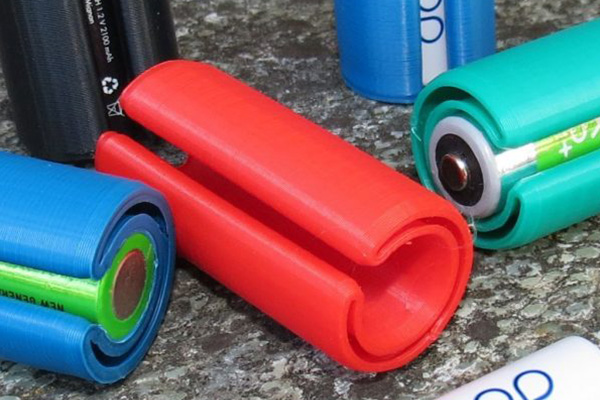
When and where possible, standardize all your battery-powered electronics on AA-sized batteries or something in the broader AA family: AAA, C, D, or even 9V. These AA-family battery shapes are the only ones that come with the NiMH LSD battery chemistry we recommend. Also, it’s surprisingly easy to convert between them with the right adapters — like sticking a AAA in a AA device — or even DIY adapters you hack together with random materials.
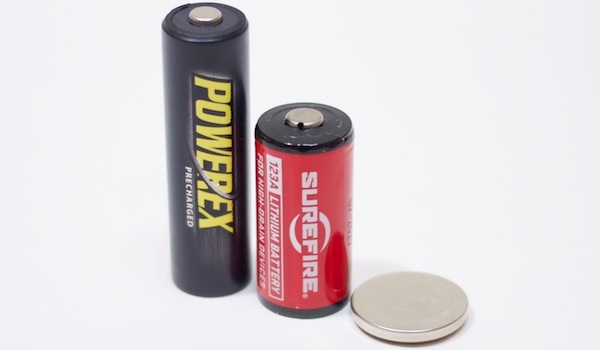
CR123A is a mature battery format that’s popular for high-end lights, and comes in lithium primary and Li-Ion rechargeable flavors. It’s great for lights you’ll use in short- to medium-term emergencies, but for long-term grid-down preps, prefer devices that can use NiMH LSD batteries in the AA family.
18650 is the best battery right now in terms of raw performance. Although loved by enthusiasts and fine as extras or bonuses, we hesitate to say 18650s are ready for preppers because they’re not standardized enough — we’ve run across too much inconsistency in the sizes and qualities available. And, as a lithium-ion format, it doesn’t have the ultra-long lifespan of the chemistry survivalists recommend.
Steps you can take today to save money and prep better
Although it seems silly to say, simply being thoughtful about your battery strategy as part of preparedness is the right first step.
Now that you know the basics and can be intentional about your strategy, most people should take these steps to start saving money while being better prepared.
Your first large goal is to change any of the standard disposable alkaline batteries sprinkled throughout the frequently-used gear in your life over to NiMH LSD rechargeables. Swap out your remotes, clocks, flashlights, toys, etc.
Quality NiMH batteries are ideal for the often-used items in a prepper’s life because they can be recharged thousands of times, so in low-use, low-drain devices like remote controls and clocks, these batteries will probably outlast the things you put them in.
Check out the review of the best rechargeable batteries for preppers to be sure you get the right ones.
There are two exceptions where we recommend using lithium primaries instead of rechargeables:
- Smoke and CO detectors. Because lithium has a higher energy capacity that stores longer than NiMH, it’s less likely the battery will die at the worst moment. And if you do need to take that battery out of the smoke detector to use in an emergency years later, it’ll likely have more charge left than a NiMH. Plus it saves you a trip up and down the ladder.
- Critical emergency gear not used in daily life, like a NOAA radio in your car kit or a backup medical device. Same thinking: You might not use that radio for five years while it sits in your trunk, but when you need it, you want to know it will turn on and stay on. Sometimes you just don’t want to bother with swapping out rechargeables in critical gear at the worst time.
If you run across gear that can’t use sizes in the AA family (a prerequisite for NiMH LSD), use lithium disposables instead and/or buy different gear when your budget allows to move as much to the AA family as possible.
Using lithiums to plug the holes where NiMH can’t go is graceful to do, because even if you can move everything over to rechargeables, it’s still a good idea to build up a stash of lithium primaries in your long-term supplies.
Only buying lithium-based batteries when buying disposables (try to never buy alkaline again!) is a no-brainer for preppers because you can stick them in a box, take them out 20 years later, and they still work better than your standard batteries. Those backups are also super helpful if you lose the ability to recharge your NiMHs in an emergency.
More: See expert’s favorite lithium-based disposable batteries.
Set the partially-used alkalines you’ve removed aside so you can randomly use them over time without replacing them, eventually working down to zero.
You’ll want to build up a NiMH LSD supply that’s at least 50% larger than what you need for daily life. That way, when a battery dies, you can quickly swap in a ready-to-go replacement while recharging the recently-empty one. Those extras also become part of your prepping supplies.
Don’t be afraid to end up with a reasonable stockpile of batteries, since the right ones will last a long time in storage.
Tip: Although NiMH LSDs aren’t as temperature sensitive as alkalines, they definitely benefit from being stored in a cooler environment, so try not to store them in a hot summer shed or car trunk.
You’ll need a well-reviewed smart charger. Don’t cheap out here — the wrong charger can be unsafe and will have a huge impact on the performance and lifespan of your expensive batteries, effectively wasting the money you spent to prep.
Most preppers will end up with one wall-powered charger for their daily use and home supplies, with a smaller USB-input charger for their bug out bag.
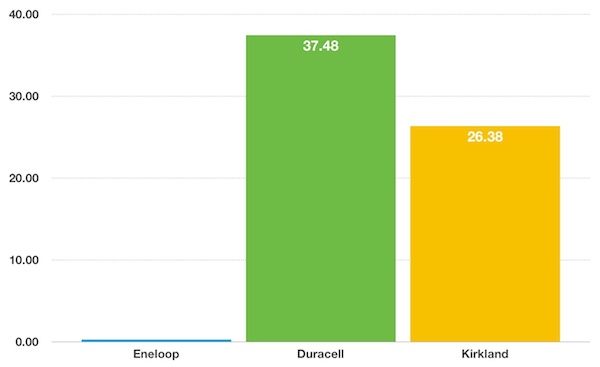
The chart above compares the total cost per charge (in cents) of Eneloops vs. two popular alkaline brands. At just $0.0027 per charge after 750 cycles, the Eneloops are so cheap they don’t even register on the chart. (The source for the numbers is this great article on the cost savings of rechargeable batteries.)
This use-and-reuse cycle in your daily life not only saves money in the long term when compared to constantly buying new alkaline disposables, but your daily use batteries become a backup layer to your prepping. You can cannibalize the batteries around your home for backups in an emergency because you’ve changed your garage remote from a worthless alkaline to a quality prep item. That’s true even if the grid goes down for a long time, because your charger can work with renewable sources like solar.
The math behind using a single battery to power a flashlight for 30 years
A Reddit user conducted runtime tests with a Zebralight H53c — a light powered by a single AA battery — and a number of very lightly used NiMH rechargeable Panasonic Eneloop Pros. Although the manufacturer claimed a runtime of 138 minutes, the tester averaged a runtime of 115 minutes at an output of 117 lumens with each battery.
Note: The Eneloop Pro used in the test is a high-capacity 2550 mAh battery, whereas we recommend the regular Eneloops with a lower capacity of 2000 mAh and a 2100-cycle lifespan. So if we cut 20 percent off the runtime numbers to adjust for the 20 percent drop in capacity, we get just over 90 minutes of runtime from a single regular Eneloop charge.
90 minutes of runtime per charge cycle multiplied by 2100 charge cycles gives us 189,000 minutes of runtime with that light over the course of the battery’s lifespan. That’s 3,150 hours of runtime at over 100 lumens of output, which means we can theoretically use a single battery to power a flashlight for one hour per night for 8.6 years!
Of course, you won’t realistically get the advertised 2100 full charge/discharge cycles out of an Eneloop, so the practical answer is probably closer to five years of use. But that’s still a crazy long time to use one battery every day for a 100-lumen beam. Add a few more batteries to your stash, and you’ll get decades of use — assuming the other parts of the setup don’t give out.
100 lumens is more than enough to follow a trail, do real work, or even read in the dark. In fact, most of the popular, inexpensive, big box retailer flashlights from brands like Energizer and Maglite have 100 lumens as their maximum output.
It’s also the case that the Zebralight’s low-power mode of 56 lumens is enough to do most of what you’ll ever want to do with a flashlight, and it gets 400 minutes of runtime at that level. With the math above, this would translate into 30 years of daily flashlight use on one battery. Of course, the battery’s NiMH chemistry will break down long before then, but you might get a solid decade or more.
The right batteries for specific emergency gear
Take the time to think through all of the preps you have in the categories below, and try to imagine how you’ll use them in an emergency and what that expected usage says about how you should optimize the mix of battery types and technologies in your stockpile.
If you have a lot of high-drain devices that will be used very infrequently, you might add more lithium primary batteries. If the devices will be used often, then prefer NiMH LSD or Li-Ion rechargeables.
Radios: Lithium disposables. There are some situations, like an incoming tornado or an electromagnetic pulse, where you need to know what’s happening quickly and want to know your (likely rarely-used) radio will work right away.
Household lights: NiMH LSD rechargeables. Stick to AA/AAA-powered lights for your emergency gear wherever possible. The same goes for headlights, lanterns, and other types of emergency lighting. Even if you’re rocking a super-high-end, 18650-powered tactical light from a top maker, keep some AA/AAA-powered lights on-hand for long-term grid-down purposes.
Tactical and weapon lights: Tactical lights should be capable of the kind of instant-on, high-lumen output that can blind an attacker. That requires high-drain, high-voltage batteries, which is why many lights use lithium or lithium-ion cells in a non-AA format.
If your lights take the popular CR123A or the newer 18650, use rechargeable Li-Ion with built-in micro-USB charging ports as the main battery with a stash of lithium primaries as a backup. (You should also have some AA/AAA-powered lights on hand somewhere in your preps for backup.)
Be careful. Li-Ion rechargeables have higher voltages (3.6V) than regular batteries in these two flavors, so do your homework to learn if they’re safe to use with your light.
Medical devices: Medical devices often have specialized battery needs, so it’s hard to make a blanket recommendation. In general, though, we encourage you to explore aftermarket battery pack alternatives for your devices — sometimes you can replace a proprietary rechargeable battery pack with a bank of AAs for travel. Otherwise, you’re stuck with buying backup batteries from the maker or with stockpiling whatever more exotic battery your device takes.
GPS and navigation: Most popular GPS/nav products take AAs, so this is an easy one. The only caveat is that you may need to do some experimenting to figure out if your device needs the full 1.5V, or if it can get by on the 1.2V output of your NiMH LSDs AAs.
Firearm optics: Many optics use batteries outside of the AA family, such as the CR2032 3V lithium cell. It’s more important to have an optic you are comfortable using regardless of battery type — so don’t feel the need to ditch your existing one — but if picking a new optic, do consider buying AA-powered.
You can get CR2032 rechargeable Li-Ion batteries, but they’ll have less than a quarter of the battery life of their primary counterparts, and the charger is bulky and fragile. We do not recommend going this route for a number of reasons:
- On lower settings, the continuous runtime for a CR2032 in some popular, high-quality optics is measured in years. So you really don’t need to stock more than a few of these tiny, lightweight batteries to have multiple decades worth of battery power for a good optic.
- If you’re really determined to carry a powered optic for many decades in a long-term grid-down, then you should either go with an optic that can take one of the main six battery types in NiMH LSD (we use and love the AA-powered Trijicon VCOG), or look into tritium- or solar-powered optics.
Specialty items: Some preppers have task-specific specialty devices, like a Kestrel wind meter, radiation detector, or thermal night vision that typically takes some flavor of the main six battery types. As with GPS/nav, you want to make sure of the device’s voltage needs before planning on bugging out with only 1.2V-capable batteries. If you do need the full 1.5V, you’ll want to have both Lithium-Ion rechargeables and lithium primaries on-hand for them.
The main six family: AAAA, AAA, AA, C, D, and 9V
If you were picking a battery size based solely on versatility, the lowly AAA battery would win because it can power devices that normally take AA, C, D, and 9V.
AAAA, AAA, AA, C, D, and 9V are part of the same family. This family doesn’t have an official name, but we refer to them as ‘the main six’. (No, of course that is not a My Little Pony fandom reference. Why would you think such a thing?!)
These can all be used interchangeably with the right adapters and some creativity. Five of the main six — AA, AAA, AAAA, C, and D batteries — have the same standardized 1.5V output. And the odd one out, 9V, is just six AAA battery cells (6 x 1.5V = 9V) wired together in series and wrapped in a single package.
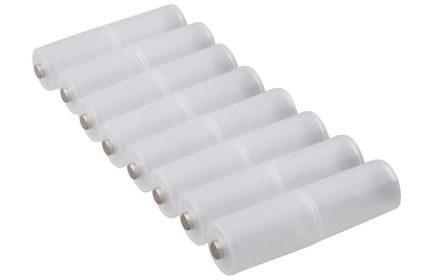
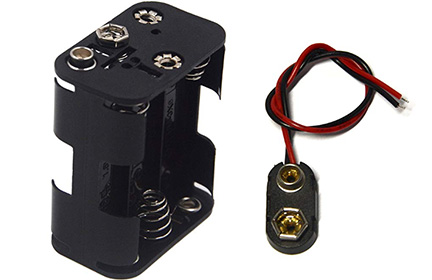
It’s possible to stack adapters. For example, you can stick an AAA inside an AA adapter and then nest that adapter inside an AA to C or D adapter.
Not only is it easy to turn AAAs into a 9V with the right adapter, you can also peel open a 9V and extract six separate AAA cells.
This adaptability is great, but don’t go overboard. Don’t go out of your way to get AAA-powered devices when those devices come in stronger variants such as AA. Nor should you stockpile huge numbers of AAAs and a bunch of adapters as your primary battery plan.
A far better way to take advantage of the flexibility of AAA is to use NiMH LSD batteries in your AAA gadgets. Combined with a full complement of adapters, you can raid those gadgets in a pinch for additional, flexible power.
Why AA is the best battery size for preppers
Try to favor products that run on AA when you’re buying battery-powered devices for preparedness. If the right product doesn’t take AA, look for AAA next, then 9V.
A big part of prepping is thinking about availability of gear before and after an emergency. Not only is AA the most common battery size that holds a decent amount of power — meaning you’re more likely to find some in a crisis — their performance has become really, really good.
The common AA battery has gone through many changes since it was first introduced in 1910. And for a period in the late 90’s, it was supposed to die out as newer, more advanced battery types took its place. But, instead of shuffling off into obsolescence, the ubiquitous AA just kept getting better as energy storage technology advanced.
Because of that mix of commonality and storage improvements, battery-powered devices have gotten better at making the most efficient use possible of the AA format’s modest voltage and capacity. A new generation of LED flashlight emitters gave us more light at lower voltages. Advanced power management technologies developed for laptops and smartphones have spread to other gadgets, which lets them sip power at such low rates that a good set of AAs can now last for years.
Case in point, the US military has made an effort to source more AA-powered optics because of the format’s availability overseas. And there’s a growing number of high-quality preparedness gear that uses AAs, such as lights and radios.
So while you might have settled for the AA in the past based mainly on its widespread availability, modern preppers who select the right AA battery are also getting a best-in-class product that’s the result of decades and billions of dollars in research.
Details on NiMH LSD batteries
Regular NiMH batteries leak their stored charge rapidly, but recent advances in battery tech have improved this chemistry’s self-discharge rate by a factor of 6X, with the result that NiMH Low Self-Discharge (LSD) batteries will retain from 75% to 85% (depending on brand and capacity) of their charge after one year. This means you can buy and store pre-charged NiMH LSD batteries in AA/AAA formats and not worry about them losing too much charge to be useful when you need them.
NIMH batteries can suffer voltage depletion if you only partially discharge them and then recharge, but this can be undone with a few full discharge/recharge cycles. A quality battery charger can perform this function, called “reconditioning,” automatically.
Partial charging is fine, on the other hand. That makes NiMH a nice fit with renewable energy sources like solar, where you may need to bring them up to full charge over the course of a few interrupted charging sessions.
NiMH’s feature an important tradeoff between storage capacity and lifespan. Higher-capacity NiMH batteries have fewer charge/discharge cycles in them, while lower-capacity versions can be stretched out over more cycles.
For long-term grid-down scenarios, the lower-capacity/higher-lifespan versions are generally the way to go, because you’ll be using these with renewables and will probably be charging them over multiple sessions — hence a higher number of charge/discharge cycles. For some specific applications, though, you may really want the extra capacity (e.g. in high-drain devices) and be willing to trade some lifespan for it.
For an example of what these tradeoffs look like, compare the Eneloop Pro (LSD) batteries, with 2500 mAh of capacity and 500 cycles, to the regular Eneloop LSD with 2100 mAh of capacity and 2100 cycles. So that 19% increase in capacity comes with a whopping 4X reduction in cycles, plus the Eneloop Pros are over 30% more expensive. For many types of daily use scenarios, this might be a decent tradeoff, but for prepping it’s pretty terrible. So stick with the regular, longer-lifespan Eneloops unless you really need the extra juice.
(There’s a higher-capacity alternative to the Eneloop Pro that makes the capacity/lifespan/cost math above look a little less terrible vs. the regular Eneloops, but we’ll go into that in our rechargeables guide.)
One minor disadvantage of NiMH LSD batteries is their 1.2V output. Given that most batteries rated at 1.5V rarely get up to that voltage, this isn’t too big a deal, but it will definitely reduce the amount of light output available to you on flashlights. And this is something to be aware of if you’re trying to power a specialized gadget that needs a full 1.5V output to work.
Finally, NiMH uses a complex charging method, so you need to invest in a high-quality smart charger that can do it the right way. Bad consumer-grade chargers can damage the batteries by overcharging them, or charging them too fast. And a low-quality smart charger will drastically reduce the number of cycles you get out of your NiMH LSDs.
Li-ion battery details and why they’re a backup to NiMH
The best ways to reduce your dependence on a dedicated NiMH charger are to have a backup charger, add a layer of lithium primary batteries to your supply, and to pick up some Li-Ion rechargeables with a built-in micro-USB charger.
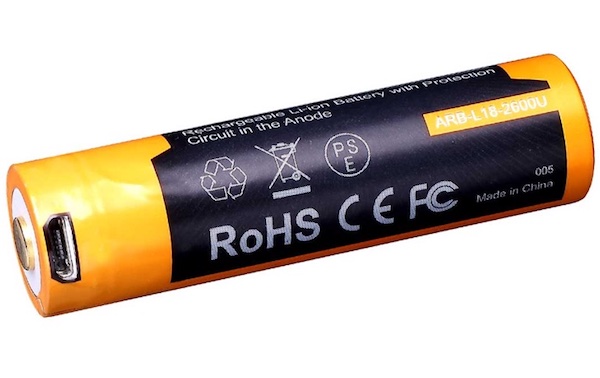
Although the price of these batteries and the requirement to top them off on a schedule makes this an expensive and high-maintenance backup measure, we still think it’s worth it for people who really want to maximize their battery preps.
Lithium-ion rechargeable batteries have less than half of the capacity of their lithium primary counterparts, but they’re often the only rechargeable option for the types of prepper products that require battery sizes that tend to come in only lithium chemistries (eg. CR123A and 18650).
Li-Ion batteries have a fairly high self-discharge rate of a few percent a month (depending on temperature), and they cannot be drained below a certain charge threshold without taking critical damage. Most Li-Ions won’t last longer than a year if idle on a shelf.
So if you store your Li-Ion batteries for too long and too much of their charge leaks out, they’re ruined.
Although lithium-ion batteries have a pretty poor shelf life, you can squeeze the most out of them by storing them at a 60% charge in cooler temperatures. The table below shows how different temps affect the self-discharge rate:

Li-Ion batteries are designed to be partially drained and recharged on a regular basis, and to be kept at about room temperature. This makes them perfect for your daily use electronics, like your smartphone or laptop, which are constantly being charged and recharged, and which you don’t leave in extreme heat.
That also makes Li-Ions good for renewable-energy chargers you might use in an emergency, because you can constantly use a little energy, do a partial recharge, use a little, recharge a little…
A full discharge is bad for these batteries, so top them off frequently as you can.
When properly cared for, a Li-Ion typically gets the equivalent of 300-500 full charge cycles.
Tips:
- Store Li-Ion batteries with a charge between 40-60%
- Don’t drain the battery below 20%, or allow it to fall that low through self-discharge
- Don’t let them get hot — try to keep them between 30-72F, and never let them get above 140F (or they might explode)
CR123A and 18650 battery basics
Although we generally recommend the AA battery size for most people, there are two battery types that are increasingly popular in the gear (particularly flashlights) and tactical enthusiast scenes: CR123A and 18650. Both come in primary and Li-Ion rechargeable forms.
CR123A
The CR123A is a 3V battery that started out as a niche camera battery in the 1990’s. Its higher voltage and capacity (the latter thanks to its lithium-based chemistry) also made it perfect for high-output flashlights of the kind favored by soldiers and law enforcement.
Though AA/AAA is gaining ground in the flashlight world, and the newer 18650 is rapidly increasing in popularity, many of the best higher-end flashlights still use CR123A.
These batteries have the standard lithium battery tech’s mix of high capacity and amazing shelf life. And when you combine those traits with their near-universal availability, you get a great battery that works really well for prepping. We still prefer the AA family of batteries, but don’t let CR123A put you off of a light you really love.
You’ll see this battery format out there under a few different names, depending on if it’s primary or rechargeable. The primaries are either CR123A or CR123 — it’s the same battery with or without the final “A.”
The rechargeable versions of this battery have a few different names: RCR123, R123, and 16340. That last name is based on size: 16mm x 34mm.
18650
The 18650 battery is the new hotness in the gear world, and for good reason. This battery, which gets its name from its physical dimensions (18mm x 65mm), powers everything from laptops to electric vehicles. Yeah, you read that right: the Tesla’s main battery bank, the one that powers the entire car, is an array of over 7,000 18650 batteries.
Because this battery format is so common now in high-end electronics, it’s the focus of intense, ongoing research and development. That means it’s currently the best thing going for capacity and longevity, and it just keeps getting better every year.
Like the CR123A that it’s currently replacing as the gear-geek favorite, all of the 18650 rechargeables are Li-Ion. Which means all of the pros and cons about Lithium-Ion apply to 18650s, too.
In all, this is a really exciting battery format that we encourage you try out if you can afford the price of entry, but know that living on the bleeding edge with this trendy new battery carries significant downsides that make the suited only for preppers who are willing to put in extra time and effort to cover every little “gotcha” that could come up.
Downside: First and foremost, the 18650’s physical layout isn’t standardized. There are flat top and button top variants, and if you match the wrong flavor of battery to the wrong device you’ll end up sending one or the other back to the store.
These batteries also have different continuous discharge ratings (CDR), and you have to match the CDR to your device. If the device tries to pull too much current (ie. exceed the CDR) the battery will overheat and take damage — it may even explode or leak.
Finally, there is a lot of scamming going on with these batteries right now. Unprotected cells are being sold as protected, and there are even outright fakes on the market. You have to be very careful to only buy recommended brands from reputable dealers.
